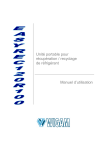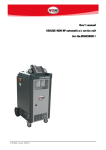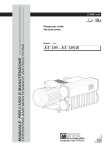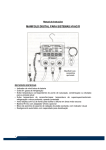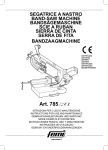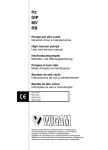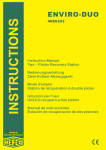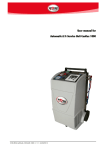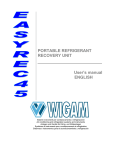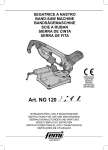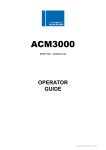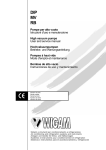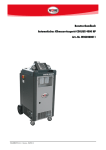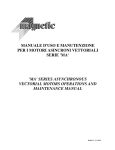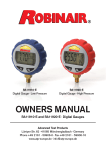Download Manuale istruzioni
Transcript
Loc.Spedale 10/b 52018 Castel San Niccolò (AR) ITALY Tel. ++39-0575-5011 Fax. ++39-0575-501200 www.wigam.com - [email protected] Manuale istruzioni UNITÀ PORTATILE PER RECUPERODI REFRIGERANTE MANUALE D’USO ITALIANO Realizzazione: WIGAM S.p.A. Stampato in Italia Prima edizione: Sett. 2009 La WIGAM S.p.a. si riserva il diritto di modificare i dati e le caratteristiche contenute nel presente manuale, senza obbligo di preavviso, nella sua politica di costante miglioramento dei prodotti. EASYREC120 SOMMARIO MANUALE D’USO ITALIANO 1 11.Troubleshooting············································································16 10.Caratteristiche tecniche································································15 9.Riarmo del pressostato di massima················································15 8.2.Interventi periodici di manutenzione ordinaria··································14 8.1.Materiale necessario······································································14 8.Manutenzione ordinaria··································································14 7.2.Procedura di raffreddamento durante il recupero······························14 7.1.Preparazione per la procedura di raffreddamento·····························13 7.Procedura di raffreddamento della bombola di recupero·················13 6.2.Trasferimento del refrigerante·························································12 6.1.Avvertenze····················································································11 6.Trasferimento del refrigerante con il metodo Push-Pull···················11 5.2.Funzione “purge”··········································································10 5.1.Avvertenze····················································································10 5.Procedura “Self-purge”··································································10 4.2.Recupero refrigerante····································································8 4.1.Avvertenze····················································································8 4.Recupero del refrigerante dall’impianto A/C····································8 3.Pannello di comando········································································7 2.3.Manometri······················································································6 2.2.Filtro······························································································6 2.1.Compressore di recupero·································································6 2.Dotazione standard e descrizione delle parti componenti················6 1.Introduzione al sistema di recupero EASYREC120····························6 Norme di sicurezza e linee guida per l’utilizzo·····································4 Schema elettrico·················································································3 Schema idraulico················································································ 2 EASYREC120 Pressostato di sicurezza Pressovacuostato SP1 SP2 Recover/Purge Valvola Recupero / Purge OUTPUT valve Valvola su linea alta pressione Valvola su linea bassa pressione Manometro mandata M2 INPUT valve Manometro aspirazione M1 ITALIANO Condensatore Ventola 3 Compressore Valvola 2 per sistema distillatore Valvola 1 per sistema distillatore 2 1 V2 V1 2 CV1 Valvola di ritegno su linea di mandata MANUALE D’USO Schema idraulico EASYREC120 Presa di corrente Interruttore principale Dispositivo di protezione per sovraccarico Motore del compressore Ventola assiale Relé Relé Relé Interruttore centrifugo Condensatore di avviamento XS SA FR M1 M2 K1 K2 K5 SR C1 Trasformatore elettronico Condensatore di marcia Interruttore By-Pass ITALIANO ST Termoprotezioni del motore 3 HL2 Indicatore di protezione bassa pressione HL1 Indicatore di protezione alta pressione SK SB1 Pulsante di avviamento SP2 Pressovacuostato SP1 Pressostato di sicurezza TC C2 MANUALE D’USO Schema elettrico EASYREC120 MANUALE D’USO ITALIANO 4 a) Leggere attentamente il presente manuale prima di utilizzare l’unità di recupero . b) L’unità di recupero è destinata esclusivamente ad operatori professionalmente preparati, che devono conoscere i fondamenti della refrigerazione, i sistemi frigoriferi, i gas refrigeranti e gli eventuali danni che possono provocare le apparecchiature in pressione. c) Indossare sempre adeguate protezioni, quali occhiali e guanti; il contatto con il refrigerante può provocare cecità e altri danni fisici. d) Non esporre l’unità al sole o alla pioggia. e) Far funzionare l’unità solo in ambienti adeguatamente ventilati e con un buon ricambio d’aria. f) Utilizzare SOLTANTO delle bombole di refrigerante ricaricabili autorizzate. Esse devono avere una pressione di lavoro minima di 27.6 bar. g) Non riempire le bombole di recupero con refrigerante liquido oltre il 75% della loro capacità massima. Un riempimento eccessivo può causare un’esplosione. h) Non superare la pressione di lavoro della bombola di recupero i) Non mischiare refrigeranti diversi in una stessa bombola. j) Prima di recuperare il refrigerante, la bombola deve raggiungere un grado di vuoto di -0.9 MPa, per poter rimuovere i gas non condensabili e eventuale umidità. k) Quando l’unità non viene utilizzata, tutte le valvole devono essere chiuse e i raccordi di entrata e uscita coperti con i loro cappucci di protezione; l’aria e l’umidità possono danneggiare le prestazioni di recupero e ridurre la durata del compressore. l) Se si usa una prolunga elettrica, la sezione dei cavi deve essere di almeno 2.0mm2 e il cavo non deve essere più lungo di 30 metri; ciò può causare abbassamento di tensione e quindi dannegiare il compressore. m) Utilizzare sempre un filtro deidratore e sostituirlo frequentemente. Ogni tipo di refrigerante deve avere il proprio filtro. Al fine di assicurare un buon funzionamento dell’unità di recupero, si consiglia di utilizzare il filtro suggerito da Wigam. n) Prestare molta attenzione quando si recupera da un sistema “bruciato”. Utilizzare due filtri per acido di alta capacità. Al termine del recupero, lavare l’unità di recupero con una piccola quantità di refrigerante pulito e con olio refrigerante per ripulire da sostanze estranee rimaste all’interno. o) L’unità ha un dispositivo di arresto automatico di alta pressione. Se la ATTENZIONE Norme di sicurezza e linee guida per l’utilizzo EASYREC120 MANUALE D’USO ITALIANO 5 pressione all’interno del sistema sale oltre 38.5 bar, l’unità si spegnerà automaticamente e la spia rossa di allarme si accenderà. Se il compressore deve essere riavviato, individuare prima la causa del problema, quindi ridurre la pressione interna al di sotto di 25 bar. Premere il tasto START per far ripartire il compressore. Quando l’unità si trova in condizione di alta pressione, riavviare l’unità dopo avere eliminato I problemi. - Soluzioni per le possibili cause di un arresto dovuto ad alta pressione: 1. Aprire la valvola OUTPUT dell’unità, se è chiusa. 2. Aprire la valvola di entrata della bombola di recupero se è chiusa. 3. Verificare se il flessibile di collegamento fra l’unità e la bombola di recupero è intasato. Se sì, chiudere la valvola OUTPUT dell’unità e la valvola di entrata della bombola, quindi cambiare flessibile. 4. La temperatura e la pressione della bombola è troppo alta (vedi la procedura di raffreddamento della bombola) p) Durante l’utilizzo del recuperatore, assicurarsi che l’impianto di condizionamento sia spento. q) L’unità ha un dispositivo di arresto automatico di bassa pressione (pressovacuostato). Se la pressione interna risulta inferiore a -0.2 ÷ 0.4bar, l’unità si spegnerà automaticamente e la spia verde si accenderà. Per riavviare il compressore, aumentare la pressione di entrata al di sopra di +0.4 bar oppure girare l’interruttore “BY-PASS” sulla posizione manuale, quindi premere il pulsante START. r) Interruttore BY-PASS : - quando l’interruttore “BY-PASS” è su AUTO, il pressovacuostato interviene. - quando l’interruttore “BY-PASS” è su MANUALE, il pressovacuostato non interviene. Girare l’interruttore sulla posizione MANUALE quando la pressione del sistema è inferiore a +0.4 bar o se il sistema necessita di un alto vuoto. s) Se la pressione della bombola supera 21 bar, usare la procedura di raffreddamento per ridurre la pressione. t) Per ottimizzare la velocità di recupero, fare uso di un flessibile più corto possibile. u) Durante il recupero di grandi quantità di refrigerante liquido, usare il metodo Push/Pull. v) Dopo il recupero, assicurarsi che non ci sia più refrigerante nell’unità. Leggere la procedura di “Self-Purge” attentamente. Se del refrigerante liquido rimane nell’unità, si può espandere e danneggiare i componenti. w) In previsione di un lungo periodo di inattività o se l’unità deve essere riposta, evacuare l’unità da ogni residuo di refrigerante e ripulirla con azoto secco. x) Consigliamo di utilizzare tubi flessibili con valvola per ridurre perdite di refrigerante. EASYREC120 MANUALE D’USO ITALIANO 6 L’attrezzatura non deve lavorare per più di 10 minuti in vuoto (-0.02Mpa) quando l’interruttore BY-PASS è sulla posizione manuale ATTENZIONE L’unità EASYREC120 è equipaggiata con due manometri a bagno d’olio Ø60mm: un manometro sulla linea di aspirazione e uno sulla linea di scarico. Essi permettono il controllo delle pressioni durante le operazioni di recupero e trasferimento del refrigerante con il metodo push-pull 2.3. MANOMETRI Il filtro deidratore è dotato di attacchi maschio 1/4"SAE. E’ fornito di tubo flessibile per facilitare il collegamento. 2.2. FILTRO L'unità modello EASYREC120 è equipaggiata con un compressore a secco ed è adatto per qualsiasi tipo di refrigerante CFC, HCFC e HFC. 2.1. COMPRESSORE DI RECUPERO 2. Dotazione standard e descrizione delle parti componenti Considerate le dimensioni ridotte e l’estrema facilità di trasporto, l'unità é particolarmente adatta per interventi su condizionatori civili, condizionatori per autoveicoli, distributori automatici, refrigeratori domestici e commerciali e deumidificatori. L'unità é dotata di un compressore a secco privo di olio lubrificante 1. Introduzione al sistema di recupero EASYREC120 EASYREC120 OUT Presa per cavo elettrico Dispositivo di protezione per sovraccarico Plug Breaker Valvola su linea alta START button Pulsante per l’avviamento dell’unità Interruttore per attivare il Valvola per selezionare le funzioni Recover o Purge Spia che indica la fine del recupero e allarme alta pressione 7 Raccordo aspirazione 1/4sae Raccordo mandata 1/4sae OUTPUT Valve START button M2 ITALIANO BY-PASS Switch presso-vacuostato Recover/Purge Valvola su linea bassa pressione INPUT Valve OUTPUT Valve pressione Light Manometro mandata M2 IN Manometro aspirazione M1 Power Switch Interruttore generale Plug BY-PASS Switch Power Switch Breaker IN INPUT Valve Recover/Purge Light M1 OUT MANUALE D’USO 3. Pannello di comando EASYREC120 MANUALE D’USO PURGE LIQUID A SCALE MUST BE USED TO AVOID OVERFILLING THE RECOVERY TANK! VAPOR INPUT OPEN FILTER MANIFOLD GAUGE SET HVAC-UNIT/APPLIANCE CONTAINING REFRIGERANT !FILTER DRIER MUST BE CONNECTED HERE! OPEN RECOVER OUTPUT START RECOVERY TANK LIQUID REFRIGERANT RECOVERY MACHING a) collegare il circuito frigorifero all'unità di recupero mediante tubi flessibili dotati di valvola a sfera , come illustrato in figura. 4.2. RECUPERO REFRIGERANTE Per recuperare il refrigerante in modo rapido ed efficace, si consiglia di collegare l'unità di recupero al circuito frigorifero attraverso un gruppo manometrico a due vie e tubi flessibili con valvola a sfera, entrambi non inclusi nella dotazione standard. Prima di iniziare le operazioni di recupero del refrigerante, il gruppo manometrico, i tubi flessibili e il filtro deidratore dovranno essere stati preventivamente evacuati. Per tutta la durata del recupero di refrigerante, il circuito frigorifero deve essere spento. 4.1. AVVERTENZE 8 ITALIANO 4. Recupero del refrigerante dall’impianto A/C EASYREC120 MANUALE D’USO ITALIANO 9 Bonificare sempre l’unità dopo ogni utilizzo. La mancata bonifica del refrigerante rimanente dall’unità, potrebbe provocare la formazione di acido nei componenti interni e causare quindi avarie premature nell’unità. ATTENZIONE b) Girare la valvola INPUT sulla posizione ”CLOSE”. Verificare che la valvola Recover/Purge è sulla posizione RECOVER. c) Collegare la valvola del tubo flessibile T2 (mandata) alla bombola di stoccaggio d) Aprire le valvole del gruppo manometrico (non fornito di serie) e) aprire la valvola della bombola di stoccaggio f) aprire le valvole dei tubi T1 e T2 (non forniti di serie) g) Girare l’interruttore generale sulla posizione “ON”, quindi premere il pulsante START per avviare l’unità h) Girare la valvola OUPUT sulla posizione “OPEN” I) Girare lentamente la valvola INPUT sulla posizione “OPEN”. j) Se il compressore inizia a fare rumore, girare lentamente indietro la valvola INPUT finché il rumore non smette. k) Se l’unità non parte, girare la valvola INPUT sulla posizione "CLOSE" e quindi avviare l’unità, il compressore e poi aprire la valvola INPUT lentamente. l) Al termine del recupero di refrigerante liquido, aprire la valvola INPUT e le uscite liquido e vapore del gruppo manometrico, le quali possono migliorare la velocità di recupero del refrigerante liquido. m) Far funzionare l’unità fino al raggiungimento del vuoto desiderato oppure finché l’unità non si ferma automaticamente (l’interruttore BYPASS si trova in posizione “AUTO”). n) Chiudere le uscite liquido e vapore del gruppo manometrico o) Spegnere l’unità di recupero. EASYREC120 MANUALE D’USO ITALIANO !FILTER DRIER MUST BE CONNECTED HERE! OPEN PURGE RECOVER OPEN START 10 a) Girare la valvola INPUT sulla posizione ”CLOSE”, girare la valvola OUTPUT sulla posizione “OPEN” (le valvole della bombola di recupero sono aperte). b) Girare la valvola Recover/Purge sulla posizione "PURGE". c) Verificare che tutti i collegamenti siano corretti d) Girare l’interruttore generale Power Switch su “ON”, quindi premere il pulsante START per avviare l’unità. e) Girare lentamente la valvola INPUT sulla posizione “PURGE” fino a raggiungere il grado di vuoto desiderato, se l’interruttore BY-PASS è in posizione manuale; oppure aspettare l’arresto automatico dell’unità se l’interruttore BY-PASS è in posizione AUTO. f) Chiudere le valvole della bombola di recupero g) Spegnere l’unità di recupero. Scollegare i tubi il filtro. h) Girare la valvola Recover/Purge sulla posizione "RECOVER" e le valvole INPUT e OUTPUT sulla posizione "CLOSE". I) Avvitare i tappi di protezione sui raccordi di entrata e uscita. 5.2. FUNZIONE “PURGE” Il filtro deidratore , una volta utilizzato con un tipo di refrigerante, ne è intimamente impregnato; pertanto, prima di utilizzare l'unità di recupero con un refrigerante diverso, è necessario sostituire il filtro deidratore ed eliminare il refrigerante residuo dall'interno dell'unità stessa. 5.1. AVVERTENZE 5. Procedura “Self-purge” EASYREC120 MANUALE D’USO ITALIANO LIQUID VAPOR FILTER SCALE INPUT VAPOR OUTPUT RECOVERY TANK LIQUID REFRIGERANT RECOVERY MACHING 11 Prima dell'uso, tutti i tubi flessibili, il filtro deidratore, la bombola di stoccaggio e l'unità di recupero devono essere stati preventivamente evacuati oppure al loro interno deve esserci refrigerante di tipo uguale a quello da trasferire. Effettuare il trasferimento del refrigerante con il circuito frigorifero spento. La bombola di stoccaggio deve avere una capacità adeguata alla quantità di refrigerante da trasferire e, comunque, non deve essere caricata oltre il 75% della sua capacità massima. Si consiglia l'impiego di una bilancia elettronica per controllare il riempimento della bombola di stoccaggio. A SCALE MUST BE USED TO AVOID OVERFILLING THE RECOVERY TANK! HVAC-UNIT/APPLIANCE CONTAINING REFRIGERANT Collegare unità di recupero e circuito frigorifero mediante un gruppo manometrico a due vie, tubi flessibili con valvola a sfera, una bombola con doppio rubinetto (liquido-vapore) e un filtro deidratore; tali componenti vengono forniti separatamente a richiesta e devono essere collegati come illustrato in figura. 6.1. AVVERTENZE L'unità di recupero, opportunamente collegata secondo il metodo pushpull, permette di trasferire rapidamente il refrigerante in forma liquida dal circuito frigorifero a una bombola esterna. 6. Trasferimento del refrigerante con il metodo Push-Pull EASYREC120 MANUALE D’USO ITALIANO 12 k) Completato il trasferimento di refrigerante, chiudere la valvola vapore della bombola (valvola senza pescante) l) Chiudere la valvola del flessibile T1 e aspettare che sul manometro di bassa M1 si legga una pressione di -0.2 bar (o aspettare che l’unità si fermi automaticamente se l’interruttore “BY-PASS” è sulla posizione “AUTO”) m) Spegnere l’unità di recupero (Interruttore generale su “OFF”) Osservare la spia di passaggio del gruppo manometrico; il trasferimento del refrigerante dal ricevitore di liquido alla bombola di stoccaggio è completo quando attraverso la spia non si vede più fluire refrigerante liquido. a) Intervenire sul circuito frigorifero affinché la maggior parte del refrigerante venga pompata nel ricevitore di liquido del sistema. b) Mediante i tubi flessibili con valvola a sfera, collegare l’attacco del ricevitore di liquido del circuito frigorifero alla valvola del liquido (con pescante) della bombola di stoccaggio (vedi figura) tramite gruppo manometrico. c) Mediante un tubo flessibile (T1) con valvola a sfera, collegare il filtro deidratore (IN) dell’unità di recupero alla valvola del vapore (valvola senza pescante) della bombola di stoccaggio d) Mediante un tubo flessibile (T2), collegare il raccordo di uscita (OUT) dell’unità di recupero all’attacco vapore del sistema A/C e) Aprire le valvole INPUT e OUTPUT dell’unità di recupero f) Aprire le valvole dei flessibili T1 e T2 dell’unità di recupero g) Aprire le valvole a sfera dei flessibili di collegamento h) Aprire le valvole sul gruppo manometrico I) aprire le valvole della bombola di stoccaggio j) Girare l’interruttore power switch su “ON”, quindi premi il pulsante START per avviare l’unità di recupero. 6.2 TRASFERIMENTO DEL REFRIGERANTE EASYREC120 MANUALE D’USO ITALIANO RECOVERY TANK LIQUID OUTPUT 13 f) Aprire le valvole Vapore e Liquido sulla bombola di recupero g) Aprire la valvola OUTPUT, quindi aprire la valvola INPUT. h) Regolare la valvola OUTPUT affinché la pressione in uscita sia superiore di 7 bar rispetto alla pressione in entrata, ma mai superiore a 21 bar I) Lasciare funzionare finché la bombola sia fredda; quindi spegnere l’unità. VAPOR FILTER INPUT a) Per iniziare occorrono almeno 0,5 kg di refrigerante liquido nella bombola b) Verificare che tutti i collegamenti siano corretti (vedi figura sotto) c) Verificare che le valvole OUTPUT e INPUT siano in posizione ”CLOSE” d) Girare la valvola Recover/Purge sulla posizione "Recover". e) Alimentare l’unità e premere sul pulsante START per avviare l’unità. 7.1. PREPARAZIONE PER LA PROCEDURA DI RAFFREDDAMENTO 7. Procedura di raffreddamento della bombola di recupero EASYREC120 MANUALE D’USO ITALIANO VAPOR LIQUID FILTER INPUT VAPOR OUTPUT RECOVERY TANK LIQUID REFRIGERANT RECOVERY MACHING 14 a) sostituire le guarnizioni degli attacchi girevoli dei tubi flessibili non appena presentano segni di usura b) sostituire il filtro ogni volta si cambia tipo di refrigerante e almeno una volta ogni 6 mesi. 8.2. INTERVENTI PERIODICI DI MANUTENZIONE ORDINARIA N° 1 MG111 Filtro deidratore standard N° 1 XH412 Filtro deidratore alta capacità N° 1 G19020 Kit di 10 guarnizioni per tubi flessibili da 1/4"SAE 8.1. Ricambi e accessori 8. Manutenzione ordinaria A SCALE MUST BE USED TO AVOID OVERFILLING THE RECOVERY TANK! HVAC-UNIT/APPLIANCE CONTAINING REFRIGERANT MANIFOLD GAUGE SET a) Verificare che tutti i collegamenti siano corretti (vedi figura sotto) b) Chiudere le due valvole del gruppo manometrico c) Seguire i punti f) g) h) i) della preparazione per la procedura di raffreddamento finché la temperature diminuirà, quindi continuare a recuperare 7.2. PROCEDURA DI RAFFREDDAMENTO DURANTE IL RECUPERO EASYREC120 MANUALE D’USO ITALIANO 5.57Kg/min 1.81Kg/min 0.25Kg/min 500 mm×250 mm×350 mm 17 kg Peso 0 ~ 40℃ 4.6Kg/min 1.57Kg/min Liquido Push/pull 0.23Kg/min Vapore Categoria IV Dimensioni Temperatura di utilizzo Velocità di recupero (kg/min) Categoria III 38.5 bar/3850kPa (558 psi) Arresto automatico di sicurezza 8A A secco, raffreddato ad aria, a pistone 5A 15 6.22Kg/min 1.85Kg/min 0.26Kg/min Categoria V 1750 rpm@60Hz Compressore Maximal current draw 1450 rpm@50Hz 370 W AC 4 Pole con condensatore di avviamento Motore Velocità motore 220-240VAC 50~60Hz Categoria V: R402A, R404A, R407A, R407B, R410A, R507 R412A, R502, R509 R407D, R408A, R409A, R411A, R411B, Alimentazione Refrigeranti Categoria IV: R22, R401A, R401B, R402B, R407C, Categoria III: R12, R134a, R401C, R406A, R500 10.Caratteristiche tecniche Al raggiungimento della pressione di 38,5 BAR, il pressostato di massima di cui l’unità è dotata, interviene inibendo tutte le funzioni; l’unità si spegnerà automaticamente e la spia rossa si accenderà. Se il compressore deve essere fatto ripartire, individuare prima la causa del problema, quindi ridurre la pressione interna al di sotto di 25 bar. Premere il tasto START per far ripartire il compressore. 9. Riarmo del pressostato di massima EASYREC120 SOLUZIONE 1. Girare la valvola INPUT su “CLOSE” e riavviare l’unità 2. E’ richiesto un servizio di assistenza 1. Leggere attentamente il manuale d’uso e seguire le istruzioni 2. Il compressore ripartirà automaticamente dopo che il motore si sarà completamente raffreddato 3. Riferirsi al paragrafo 4.2 k) e l), quindi procedere con l’operazione “self- purge” 1. Ridurre la temperatura della bombola con la procedura di raffreddamento 2. E’ richiesto un servizio di assistenza 1. Stringere i flessibili di collegamento 2. E’ richiesto un servizio di assistenza 1. Il pressostato di massima è intervenuto 2. Il pressovacuostato è intervenuto (spia verde accesa) 1. La pressione di entrata è troppo alta 2. Guasto nel motore o in un altro componente elettrico 1. Il pressostato di massima è intervenuto in seguito ad un’operazione sbagliata, come per es. le valvole OUTPUT dell’unità o della bombola di recupero sono chiuse 2. Termoprotettore intervenuto, ma ventola assiale gira sempre 3. Il recupero è terminato e la pressione è minore del punto d’intervento del presso/vacuostato 1. La pressione nella bombola di recupero è troppo alta 2. Le guarnizioni di tenuta del compressore sono logore 1. I flessibili di collegamento sono allentati 2. Presenza di una perdita nell’ unità Dopo aver premuto il pulsante START, il compressore non si avvia ma la ventola parte Il compressore non lavora Il compressore parte ma si ferma dopo alcuni minuti Il recupero è troppo lento L’unità non riesce ad andare in vuoto 16 1. Ridurre la pressione nel sistema 2. Il circuito di entrata è bloccato, riarmare dopo aver eliminato i problemi 1. Verificare se l’unità è ben collegata 2. Girare l’interruttore BY-PASS sulla posizione manuale 1. Unità scollegata elettricamente 2. Il dispositivo di protezione per sovraccarico è interventuo CAUSA La ventola non parte PROBLEMA ITALIANO 1. Collegare elettricamente l’unità 2. Riarmare il dispositivo di protezione dopo aver fatto raffreddare per 5 minuti MANUALE D’USO 11. Troubleshooting EASYREC120 User’s manual PORTABLE REFRIGERANT RECOVERY UNIT USER’S MANUAL ENGLISH Layout: WIGAM S.p.A. Printed in Italy 1st edition: Sep. 2009 WIGAM S.p.A. reserves the right to discontinue, or change at any time specifications or designs without notice and without incurring obligations according to her policy of always improving her products. EASYREC120 INDEX USER’S MANUAL ENGLISH 19 11.Troubleshooting···········································································34 10.Technical features········································································33 9.Max pressure switch resetting························································33 8.2.Periodical operations for ordinary maintenance································32 8.1.Required material··········································································32 8.Ordinary maintenance····································································32 7.2.Tank Cooling Procedure in the recovering process····························32 7.1.Pre-work Cooling method·······························································31 7.Recovery tank cooling method························································31 6.2.Refrigerant transfer·······································································30 6.1.Warning························································································29 6.Refrigerant Transfer with Push-Pull method···································29 5.2.Drainage – “purge” function····························································28 5.1.Warning························································································28 5.Self Purge Method··········································································28 4.2.Refrigerant recovery······································································26 4.1.Warning························································································26 4.Refrigerant recovery from the A/C system·······································26 3.Control panel·················································································25 2.3.Pressure gauges···········································································24 2.2.Filter····························································································24 2.1.Recovery compressor····································································24 2.Standard equipment and components description··························24 1.Introduction to the recovery unit EASYREC line······························24 Safety precautions············································································22 Wiring diagram·················································································21 Hydraulic diagram ············································································ 20 EASYREC120 USER’S MANUAL Pressure/vacuum switch Valve on low pressure line SP2 INPUT valve Recover/Purge Recovery/Purge valve OUTPUT valve Valve on high pressure line Safety pressure switch SP1 Condenser Fan 3 Compressor Valve 1 for distiller system 2 1 V2 V1 Delivery pressure gauge M2 Valve 1 for distiller system CV1 Check valve on delivery line Suction pressure gauge 20 ENGLISH M1 Hydraulic diagram EASYREC120 Axial fan Relay Relay Relay M2 K1 K2 K5 Start capacitor Compressor motor M1 C1 Overload protection device FR Centrifugal switch Rocker switch SA SR Power outlet XS Electronic transformer Running capacitor BY-PASS switch ST Motor thermal protectors HL2 Low pressure protection indicator 21 ENGLISH HL1 High pressure protection indicator SK SB1 Start button SP2 Pressure/vacuum switch SP1 Safety pressure switch TC C2 USER’S MANUAL Wiring diagram EASYREC120 WARNING USER’S MANUAL ENGLISH 22 Read all safety, operating guidelines and instructions before operating this unit. z) Only a qualified technician should operate this recovery unit! aa) Always wear safety glasses and protective gloves while working with refrigerants to protect your eyes and skin from refrigerant gases and refrigerant liquid. Avoid getting in touch with caustic liquid or gas. bb) Do not expose the equipment to the sun or rain. cc) Be sure that any room where you are working is thoroughly ventilated. dd) Use ONLY authorized refillable refrigerant tanks. It requires the use of recovery tanks with a minimum working pressure of 27.6 bar. ee) Do not overfill the recovery tank. Tank is full at 75% capacity. There should be enough space for liquid expansion. Overfilling of the tank may cause a violent explosion. ff) Do not exceed the working pressure of the recovery tank cylinder. gg) Do not mix different refrigerants together in one tank, or they could not be separated or used. hh) Before recovering the refrigerant, the tank should achieve the vacuum level: -0.9 MPa, which is for purging non-condensable gases. ii) When the unit is not used, all valves should be closed and the input and output fittings should be covered with their protective caps, as air and/or moisture may damage the recovery performances and shorten the service life of compressor. jj) If using an extension power cord, it should be a minimum 2.0mm2 wires section and no longer than 30 meters, or it may make the voltage drop and damage the compressor. kk) A filter drier must always be used and should be replaced frequently. Each type of refrigerant must have its own filter. For the sake of ensuring the normal operation of the unit, please use the filter specified by our company. High quality filter drier will bring high quality services. ll) Special care should be taken while recovering from a "burned-out" system. Use two high acid capacity filters in series. When you have finished recovering from the system, flush the unit with a small amount of clean refrigerant and refrigerant oil to purge off foreign substances left inside. mm)The unit has an Internal High Pressure Shut Off Switch. If the pressure inside the system goes above 38.5 bar, the unit will automatically shut itself off and the Red Alarm Light will turn on. If the compressor needs y) Safety precautions and Operation guidelines EASYREC120 vv) uu) tt) ss) rr) qq) pp) oo) nn) USER’S MANUAL ENGLISH 23 to be restarted, please find out the cause first, then reduce the internal pressure below 25 bar. Press the START button to restart the compressor. When the unit is under high pressure condition, restart the unit after eliminating the troubles -Solutions for possible causes of High Pressure Shut Off: 1. Open the output valve of the unit if it's closed. 2. Open the input valve of the recovery tank if it's closed. 3. Check if the hose connected between the unit and the recovery tank is jammed. If yes, please close the output valve of the unit and the input valve of the recovery tank and then change a new one. 4. The temperature and the pressure of the recovery tank is too high (see recovery tank cooling method) While using the recovery unit, make sure the power of the airconditioning system is off The unit has an Internal Low Pressure Shut Off Switch (Pressure/vacuum switch). The unit will automatically shut itself off if the inner pressure is lower than -0.2 ÷ -0.4bar and the green alarm light will turn on. To restart the compressor, please increase the input pressure above +0.4 bar or rotate the “BY-PASS switch” to the MANUAL position, then press the START button. BY-PASS switch : - when the BY-PASS switch is on AUTO, the pressure/vacuum switch can work, - when the BY-PASS switch is on MANUAL, the pressure/vacuum switch can’t work. Please turn to the “Manual” position when the system pressure is lower than +0.4 bar or the system needs high vacuum. If the tank pressure exceeds 21 bar, use the Recovery Tank Cooling Method to reduce the tank pressure. To maximize recovery rates, use the shortest possible length of 3/8" or larger hose. While recovering large amounts of liquid, use the liquid Push/Pull method. After recovering, make sure there is no refrigerant left in the unit. Read the Self-Purging Method carefully. If liquid refrigerant remains in the unit, it can expand and damage the components. If the unit is to be stored or not used for any length of time, we recommend that it be completely evacuated of any residual refrigerant and purged with dry nitrogen. We suggest to use the hose with valve in order to reduce the loss of the refrigerant EASYREC120 USER’S MANUAL ENGLISH 24 This equipment must NOT work for more than 10 minutes in vacuum (-0.02Mpa) when the BY-PASS switch” is on the MANUAL position WARNING The unit EASYREC line is equipped with two oil-filled pressure gauges Ø60mm: one pressure gauge on the suction line and one on the discharge line. They allow to check the pressure during recovery and refrigerant transfer with the push-pull method. 2.3. PRESSURE GAUGES The filter is equipped with two 1/4sae male connections. It is supplied with a hose to make the connection easier. 2.2. FILTER The unit model EASYREC line is equipped with an oil-less compressor and is suitable for any type of CFC, HCFC and HFC refrigerant. 2.1. RECOVERY COMPRESSOR 2. Standard equipment and components description Considering its reduced volume and the extreme facility of transportation, the unit is suited for interventions on civil conditioners, automotive vehicle conditioners, dispensers, domestic and commercial refrigerators and dehumidifiers. The unit is supplied with an oil-less compressor without lubricant. 1. Introduction to the recovery unit EASYREC line EASYREC120 OUT Plug Plug for electrical cable OUTPUT Valve line Valve on high pressure Valve on low pressure line Delivery pressure gauge M2 INPUT Valve Suction pressure gauge M1 Power Switch Main Power switch Plug BY-PASS Switch Power Switch Breaker IN INPUT Valve Recover/Purge Light M1 START button Button to start the unit Switch to activate the BY-PASS Switch pressure vacuum switch 25 Valve to select the Recovery or Purge function Light that indicates the end of recovery Light Recover/Purge 1/4sae suction connection 1/4sae delivery connection OUTPUT Valve START button M2 ENGLISH IN OUT USER’S MANUAL 3. Pannello di comando EASYREC120 USER’S MANUAL ENGLISH PURGE LIQUID A SCALE MUST BE USED TO AVOID OVERFILLING THE RECOVERY TANK! VAPOR INPUT OPEN FILTER MANIFOLD GAUGE SET HVAC-UNIT/APPLIANCE CONTAINING REFRIGERANT !FILTER DRIER MUST BE CONNECTED HERE! OPEN RECOVER OUTPUT START RECOVERY TANK LIQUID REFRIGERANT RECOVERY MACHING 26 a) Connect the refrigerant circuit to the recovery unit by means of flexible hoses with ball valve, as shown by the picture. 4.2. REFRIGERANT RECOVERY To recover the refrigerant in a quick and efficient way, we suggest to connect the recovery unit to the cooling system by means of a 2-way manifold and flexible hoses with ball valves, which are not included in the standard equipment. Before starting refrigerant recovery, the manifold, the flexible hoses and the filter drier must have been previously evacuated. During refrigerant recovery, the cooling system must be turned off. 4.1. WARNING 4. Refrigerant recovery from the A/C system EASYREC120 USER’S MANUAL ENGLISH 27 Always purge the unit after each use. Failure to purge the remained refrigerant from the unit could result in the acidic degradation of internal components and ultimately cause premature failure of the unit. WARNING b) Turn the INPUT valve to the ”CLOSE” position. Make sure the Recover/Purge valve is set on the RECOVER position. c) Connect the T2 flexible hose valve (delivery) to the recovery tank. d) Open the manifold valve (manifold is not supplied with the unit) e) Open the recovery tank’s valve f) Open the T1 and T2 flexible hoses valves (flexible hoses are not supplied with the unit) g) Turn the Power Switch to the “ON” position, then press the START button to start the recovery unit h) Turn the OUTPUT valve to the “OPEN” position I) Gradually turn the INPUT valve to the “OPEN” position. j) If the compressor starts to knock, slowly throttle back the INPUT valve until the knocking stops. k) If the unit fails to start, please turn the INPUT valve to the "CLOSE" position, and then start the power supply, start the compressor, then open the INPUT valve slowly. l) When finishing the liquid recovery, open the INPUT valve and the vapour and liquid ports of the manifold gauge sets which can improve the liquid recovery speed m) Run until desired vacuum is achieved or until the unit stops automatically (the “by-pass switch” is on the “AUTO” position). 1. Close the vapour and liquid ports of the manifold gauge sets. 2. Turn the unit off. EASYREC120 USER’S MANUAL ENGLISH !FILTER DRIER MUST BE CONNECTED HERE! OPEN PURGE RECOVER OPEN START 28 j) Turn the INPUT valve to the “CLOSE” position, turn the OUTPUT valve to the “OPEN” position (recovery tank valves are open). k) Turn the Recover/Purge valve to the "PURGE" position. l) Make sure all connections are correct and tight (same as recovery mode) m) Turn the Power Switch to the “ON” position, then press the START button to start the unit. n) Slowly turn the INPUT valve to the “PURGE” position until the desired vacuum level is achieved if the BY-PASS switch is on the manual position; or wait until the unit stops automatically if the BY-PASS switch is on the AUTO position. o) Close the valves on the recovery tank p) Turn the unit off. Disconnect all hoses and filter drier. q) Turn back the Recover/Purge valve to the "RECOVER" position and the INPUT and OUTPUT valves to the "CLOSE" position. r) Screw the protective caps on the input and output fittings. 5.2. DRAINAGE – “PURGE” FUNCTION Once the filter drier has been used with a type of refrigerant, it is closely imbued with it; so, before using the recovery unit with a different refrigerant, it is necessary to replace the filter drier and eliminate the residual refrigerant from the unit itself. LIQUID VAPOR FILTER SCALE INPUT VAPOR OUTPUT RECOVERY TANK LIQUID REFRIGERANT RECOVERY MACHING 29 Before use, make sure that all the flexible hoses, the filter drier, the stocking cylinder and the recovery unit have been previously evacuated or that they contain the same refrigerant as the one to be transferred. Make the refrigerant transfer with the refrigerant’s system turned off. The stocking cylinder must have a capacity equal to the quantity of refrigerant that has to be removed; anyhow, it must not be charged above 75% of its maximum capacity. It is recommended to use an electronic scale in order to check the refilling of the stocking cylinder. A SCALE MUST BE USED TO AVOID OVERFILLING THE RECOVERY TANK! HVAC-UNIT/APPLIANCE CONTAINING REFRIGERANT Connect the recovery unit and the refrigerant circuit by means of a two-way manifold, flexible hoses with ball valve, a cylinder with double valve (liquidvapour) and a filter drier; these items are supplied separately on request and must be connected as shown in the picture: 61. WARNING Duly connected by means of the push-pull method, the recovery unit allows the rapid transfer of the liquid refrigerant from the refrigerant system to an external cylinder. EASYREC120 5.1. WARNING ENGLISH 6. Refrigerant Transfer with Push-Pull method USER’S MANUAL 5. Self Purge Method EASYREC120 USER’S MANUAL ENGLISH 30 The recovery of the residual gaseous refrigerant from the inside refrigerant system can be done by connecting the unit as shown in “4.2 Refrigerant Recovery” aa) When the refrigerant transfer has been completed, close the cylinder vapour valve (valve without tube) bb) Close the valve of the T1 hose and wait until you can read a pressure of -0.2 bar on the M1 low pressure gauge (or wait for the automatic stop of the unit if the “BY-PASS switch” is on the “AUTO” position) cc) Turn the recovery unit off (Power switch to the “OFF” position) dd) Close the cylinder liquid valve and the flexible hose ball valve connected to it. ee) Close the valve of the T2 flexible hose ff) Close all the manifold and flexible hoses valves used for connections Watch the manifold sightglass; the refrigerant transfer from the liquid receiver to the stocking cylinder is complete when you can see through the sightglass that the liquid refrigerant has stopped flowing. q) Operate on the refrigerant’s system in order that most part of the refrigerant will be pumped into the liquid side of the system. r) By means of the flexible hoses with ball valve, connect the cooling system liquid receiver connection to the stocking cylinder liquid valve (with tube) (see the above picture) s) By means of the flexible hose (T1) with ball valve, connect the recovery unit filter drier (IN) to the stocking cylinder vapour valve (valve without tube) t) By means of a flexible hose (T2), connect the exit connection (OUT) of the recovery unit to the A/C system vapour connection u) Open the INPUT and OUTPUT valves of the recovery unit v) Open the valves of the flexible hoses T1 and T2 of the recovery unit w) Open the connecting flexible hoses ball valves x) Open the manifold valves y) Open the stocking cylinder valves z) Switch the power switch to the “ON” position, then press the START button to start the unit. 6.2 REFRIGERANT TRANSFER EASYREC120 USER’S MANUAL ENGLISH RECOVERY TANK LIQUID OUTPUT 31 o) Open the Vapour and Liquid valves on the recovery tank. p) Open the OUTPUT valve, then open the INPUT valve of the unit. q) Regulate the OUTPUT valve of the unit so that the output pressure is 7 bar more than the input pressure, but never more than 21 bar VAPOR FILTER INPUT j) Before starting, there must be at least 0,5 kg of liquid refrigerant in the tank k) Make sure all connections are correct and tight (refer to the below picture) l) Make sure the OUTPUT valve and INPUT valve are on the ”CLOSE” position m) Turn the Recover/Purge valve to the "Recover" position. n) Power on and then press the START button to start the unit. 7. 1. PRE-WORK COOLING METHOD 7. Recovery tank cooling method EASYREC120 USER’S MANUAL ENGLISH VAPOR LIQUID INPUT FILTER VAPOR OUTPUT RECOVERY TANK LIQUID REFRIGERANT RECOVERY MACHING 32 a) Replace the swivel connections gaskets of the flexible hoses as soon as they show worn marks. b) Replace the filter each time a different type of refrigerant is used and at least once every six months. 8.2. PERIODICAL OPERATIONS FOR ORDINARY MAINTENANCE N° 1 MG111 Standard drier filter N° 1 XH412 High capacity drier filter N° 1 G19020 Kit of 10 gasket for flexible hose with 1/4 SAE connections 8 .1. Spare parts and accessoires 8. Ordinary maintenance A SCALE MUST BE USED TO AVOID OVERFILLING THE RECOVERY TANK! HVAC-UNIT/APPLIANCE CONTAINING REFRIGERANT MANIFOLD GAUGE SET d) Make sure all connections are correct and tight (refer to below picture) e) Close the two valves of the manifold gauge set f) Follow the f) g) h) i) steps of the Pre-work Cooling Procedure until the temperature will decrease, then continue to recover 7.2. TANK COOLING PROCEDURE IN THE RECOVERING PROCESS EASYREC120 USER’S MANUAL ENGLISH 5.57Kg/min 1.81Kg/min 0.25Kg/min 500 mm×250 mm×350 mm 17 kg Weight 0 ~ 40℃ 4.6Kg/min 1.57Kg/min Liquid Push/pull 0.23Kg/min Vapor Dimensions Operating temperature Recovery rate (kg/min) Category IV 38.5 bar/3850kPa (558 psi) Automatic safety shut-off Category III Oil-less, air-cooled, piston 5A 8A 33 6.22Kg/min 1.85Kg/min 0.26Kg/min Category V 1750 rpm@60Hz Compressor Maximal current draw 1450 rpm@50Hz 370 W AC 4 Pole start capacitor running capacitor Motor Motor speed 220-240VAC 50~60Hz Category V: R402A, R404A, R407A, R407B, R410A, R507 R412A, R502, R509 R407D, R408A, R409A, R411A, R411B, Power Refrigerants Category IV: R22, R401A, R401B, R402B, R407C, Category III: R12, R134a, R401C, R406A, R500 10. Technical features When a pressure of 38,5 BAR is reached, the max pressure switch, which is in the unit, operates by restraining all functions; the unit will automatically shut itself off and the Red Alarm Light will turn on. If the compressor needs to be restarted, please find out the cause first, then reduce the internal pressure below 25 bar. Press the START button to restart the compressor. 9. Max pressure switch reset EASYREC120 USER’S MANUAL 1. Turn the INPUT valve to “CLOSE” and restart the unit 2. Factory service is required 1. Read carefully this operating manual and follow the instructions 2. The compressor will restart automatically after the motor is completely cooled 3. Take a new tank and then press the START button to start the compressor 4. Refer to step 4.2 k) and l), then proceed with self-purge operation 1. Reduce the tank temperature with the Recovery Tank Cooling Method 2. Factory service is required 1. Output pressure is too high 2. Failure in the motor, or other electrical components 1. High pressure shuts off due to wrong operation, such as output valves of the unit or recovery tank are not open 2. Thermal protector is disconnected, but axial fan still running 3. The recovery tank is full at 80% capacity 4. Recovery is over and the unit is under low pressure switching point 1. The pressure inside the recovery tank is too high 2. The compressor seals are worn out 1. Connecting hoses are loose 2. There is a leakage in the unit The compressor can’t work The compressor starts but cuts off within a few minutes Recovery process is too slow The unit doesn't pull out a vacuum 34 1. Reduce the system pressure 2. The input loop is blocked, reset after eliminating troubles 3. Check if well connected 4. Turn the “by-pass switch” to the restart position 1. The unit is in high pressure shut off (Red alarm light turns on) 2. The unit is under low pressure protection (Green light turns on) After pressing the START button, the compressor doesn't start but the fan runs 1. Tighten the connecting hoses 2. Factory service is required 1. Connect the power supply cord 2. Reset the circuit breaker when it’s cooling after 5 minutes 1. Power supply cord is not connected 2. The circuit breaker has cut off Fan does not run PROBLEM ACTION ENGLISH CAUSE 11. Troubleshooting EASYREC120 Sistemi e strumenti per condizionamento e refrigerazione Air conditioning and refrigeration systems and instruments Anlagen und Geräte für Klima- und Kälteanlagen Systèmes et instruments pour conditionnement et refrigération Sistemas e instrumentos para el acondicionamiento y refrigeración Manual de uso ESPAÑOL UNIDAD PORTATIL DE RECUPERACIÓN DE REFRIGERANTE MANUAL DE USO ESPAÑOL Realización: WIGAM S.p.A. Impreso en Italia Primera edición: Sep. 2009 WIGAM S.p.a. se reserva el derecho de modificar los datos y las características contenidas en el presente manual, sin obligación de preaviso, en su política de constante mejora de losproductos. EASYREC LINE INDICE MANUAL DE USO ESPAÑOL 37 10.Solución de problemas··································································52 9.Características técnicas·································································51 8.Rearme del presostato de máxima···················································51 7.2.Intervenciones periódicas de mantenimiento ordinario······················50 7.1.Material necesario·········································································50 7.Mantenimiento ordinario·································································50 6.2.Procedimiento de enfriamiento durante la recuperación····················50 6.1.Preparación para el procedimiento de enfriamiento··························49 6.Procedimiento de enfriamiento de la botella de recuperación········ · 4 9 5.2.Transferencia del refrigerante·························································48 5.1.Advertencias·················································································47 5.Trasferencia del refrigerante con el método Push-Pull·················· · · 4 7 4.4.Función “purga”············································································46 4.3.Advertencias·················································································46 4.2.Recuperación del refrigerante························································44 permanecer apagado ··········································································44 Durante la recuperación del refrigerante el circuito frigorífico ha de 4.1.Advertencias·················································································44 4.Recuperación del refrigerante de la instalación A/C························44 3.Panel control··················································································43 2.3.Manómetros··················································································42 2.2.Filtro·····························································································42 2.1.Compresor de recuperación····························································42 2.Dotación standard y descripción de los componentes····················· 4 2 1.Introducción al sistema de recuperación EASYREC line··················42 Normas de seguridad y guía para el uso············································ · 4 0 Esquema eléctrico ·············································································39 Esquema hidráulico···········································································38 EASYREC LINE Manóme tro desc arga Presos tato de segu ridad Presovacuostato M2 SP1 SP2 Ventilador 3 OUTPUT valve Válvula de alta presión Recover/Purge Válvula de Recup eración/Purga Condensador Compresor Válvula 2 para sistema destilación Válvula 1 para sistema destilación 2 1 V2 V1 Válvula de baja presión INPUT valve Manóme tro aspi ración M1 ESPAÑOL 38 CV1 Válvula de retención línea de descarga MANUAL DE USO Esquema hidráulico EASYREC LINE Toma de corriente Interruptor principal Dispositivo de protección sobrecargas Motor del compresor Ventilador axial Relé Relé Relé Interruptor centrifugo Condensador de arranque XS SA FR M1 M2 K1 K2 K5 SR C1 Transformador Condensador de marcha Interruptor By-Pass ST Protector térmico del motor HL2 Indicador de protección baja presión 39 ESPAÑOL HL1 Indicador de protección alta presión SK SB1 Pulsador de arranque SP2 Presovacuostato SP1 Presostato de seguridad TC C2 MANUAL DE USO Esquema eléctrico EASYREC LINE MANUAL DE USO ESPAÑOL 40 a) lea atentamente el presente manual; el riguroso cumplimiento de los procedimientos que se indican es condición esencial para la seguridad del operario, la integridad de los aparatos y la constancia en las prestaciones declaradas. b) este aparato ha sido creado exclusivamente para operarios profesionalmente preparados que han de conocer los fundamentos de la refrigeración, los sistemas frigoríficos, los gases refrigerantes y los posibles daños que pueden provocar los aparatos de presión. c) aconsejamos que utilice protecciones adecuadas como gafas y guantes; el contacto con el refrigerante puede provocar ceguera y otros daños físicos al operario. d) No exponer la unidad al sol o a la lluvia. e) haga funcionar el equipo sólo en ambientes correctamente ventilados y con un buen intercambio de aire. f) Utilizar SOLAMENTE envases de refrigerante recargables autorizadas. Deben tener una presión de trabajo mínima de 27.6 bar. g) Non rellenar las botellas de recuperación con refrigerante líquido por encima del 75% de su capacidad máxima. Un rellenado excesivo puede causar su explosión. h) No superar la presión de trabajo de la botella de recuperación I) No mezclar refrigerantes distintos en la misma botella. j) Antes de recuperar el refrigerante, la botella debe tener un nivel de vacío de 0.9 MPa, para poder eliminar los gases incondensables y la posible humedad. k) Cuando la unidad no se usa, todas las válvulas deben estar cerradas y los racores de entrada y salida cubiertos con su tapón de protección; el aire y la humedad pueden dañar las prestaciones de recuperación y reducir la duración del compresor. l) Si se usa un alargador eléctrico, la sección de los cables debe de ser de al menos 2.0mm2 y el cable no debe de ser más largo de 30 metros; esto puede causar bajadas de tensión y dañar el compresor. m) Utilizar siempre un filtro deshidratador y sustituirlo frecuentemente. Cada tipo de refrigerante debe de tener su propio filtro. Para asegurarse del buen funcionamiento de la unidad de recuperación, se aconseja utilizar el filtro sugerido por Wigam. n) Prestar mucha atención cuando se recupera de un sistema “quemado”. Usar dos filtros antiácidos de alta capacidad. Al finalizar la recuperación, limpiar la unidad de recuperación con una pequeña cantidad de refrigerante limpio y con aceite refrigerante para limpiar de sustancias extrañas depositadas en el interior. o) La unidad lleva un dispositivo de parada automáticas de alta presión. Si la ATENCIÓN Normas de seguridad y guía para el uso EASYREC LINE MANUAL DE USO ESPAÑOL 41 presión en el interior del sistema supera los 38.5 bar, la unidad de para automáticamente y el led rojo de alarma se enciende. Si el compresor debe de ser re arrancado, identificar antes la causa del problema, entonces reducir la presión por debajo de 25 bar. Pulsar la tecla START para re arrancar el compresor. Cuando la unidad esta en condiciones de alta presión, re arrancar la unidad después de haber eliminado el problema. -Soluciones para las posibles causas de parada debido a alta presión: 1. Abrir la válvula OUTPUT de la unidad si está cerrada. 2. Abrir la válvula de entrada de la botella de recuperación si está cerrada. 3. Compruebe si el tubo flexible de conexión entre la unidad y la botella de recuperación está obstruido. Si esta obstruido, cerrar la válvula OUTPUT de la unidad y la válvula de entrada de la botella, entonces cambiar el tubo flexible. 4. La temperatura y la presión de la botella es demasiado alta (ver el procedimiento de enfriado de la botella) p) Durante el uso del recuperador, asegurarse que la instalación de climatización o refrigeración este apagada. q) La unidad tiene un dispositivo de parada automática de baja presión (Presovacuostato). Si la presión interna resulta inferior a -0.2 ÷ -0.4bar, la unidad se apagará automáticamente y el visor verde se encenderá. Para re arrancar el compresor, aumentar la presión de entrada por encima de +0.4 bar o bien girar el interruptor “BY-PASS” a la posición manual, entonces pulsar la tecla START. r) Interruptor BY-PASS : - Cuando el interruptor “BY-PASS” está en AUTO, el Presovacuostato actúa. - Cuando el interruptor “BY-PASS” está en MANUAL, el presovacuostato no interviene. Girar el interruptor a la posición MANUAL cuando la presión del sistema es inferior a +0.4 bar o si el sistema necesita un alto vacío. s) Si la presión de la botella supera los 21 bar, usar el procedimiento de enfriamiento para reducir la presión. t) Para optimizar la velocidad de recuperación, hacer uso de un tubo flexible lo más corto posible. u) Para recuperar grandes cantidades de refrigerante líquido, usar el método Push/Pull. v) Después de la recuperación, asegurarse que no quede más refrigerante en la unidad. Leer el procedimiento de “Auto-Purga” atentamente. Si el refrigerante líquido permanece en la unidad, se puede expandir y dañar los componentes. w) En previsión de largos periodos de inactividad o si la unidad debe ser devuelta, evacuar la unidad de cualquier residuo de refrigerante y limpiela con nitrógeno seco. x) Aconsejamos utilizar tubos flexibles con válvula para reducir perdidas de refrigerante. EASYREC LINE MANUAL DE USO ESPAÑOL 42 El equipo no debe trabajar más de 10 minutos en vacío (-0.02Mpa) cuando el interruptor BY-PASS está en posición manual ATENCIÓN La unidad EASYREC line está equipada con dos manómetros con glicerina Ø60mm: un manómetro en la línea de aspiración y otro en la línea de descarga. Permiten el control de la presión durante la recuperación y la transferencia de refrigerante con el método push-pull 2.3. MANÓMETROS El filtro deshidratador está dotado de conexiones macho 1/4"SAE. Se suministra el tubo flexible para facilitar las conexiones. 2.2. FILTRO La unidad modelo EASYREC line está equipada con un compresor en seco y adecuado para cualquier tipo de refrigerante CFC, HCFC y HFC. 2.1. COMPRESOR DE RECUPERACIÓN 2. Dotación standard y descripción de los componentes Consideradas las dimensiones reducidas y la extrema facilidad de transporte, la unidad es particularmente adecuada para trabajar en acondicionadores domésticos, acondicionadores de vehículos, distribuidores automáticos, refrigeradores domésticos y comerciales y deshumidificadores. La unidad está dotada de un compresor en seco sin aceite lubricante 1. Introducción al sistema de recuperación EASYREC line EASYREC LINE OUT Breaker Plug Dispositivo de protección para sobrecargas Toma para cable eléctrico OUTPUT Valve presión Interruptor para activar el Válvula para seleccionar las funciones Recover o Purge Led que indica el final de la recuperación y alarma de alta presión Racor aspiración 1/4sae Racor descarga 1/4sae OUTPUT Valve START button START button M2 ESPAÑOL 43 Pulsador para el arranque de la unidad BY-PASS Switch preso-vacuostato Recover/Purge Válvula línea de baja presión INPUT Valve Válvula línea de alta Light Manómetro descarga M2 IN Manómetro aspiración M1 OUT MANUAL DE USO Power Switch Interruptor general Plug BY-PASS Switch Power Switch Breaker IN INPUT Valve Recover/Purge Light M1 3. Panel control EASYREC LINE MANUAL DE USO ESPAÑOL PURGE LIQUID A SCALE MUST BE USED TO AVOID OVERFILLING THE RECOVERY TANK! VAPOR INPUT OPEN FILTER MANIFOLD GAUGE SET HVAC-UNIT/APPLIANCE CONTAINING REFRIGERANT !FILTER DRIER MUST BE CONNECTED HERE! OPEN RECOVER OUTPUT START RECOVERY TANK LIQUID REFRIGERANT RECOVERY MACHING 44 a) conectar el circuito frigorífico a la unidad de recuperación mediante tubos flexibles dotados de válvulas de bola, como se ilustra en la figura. 4.2. RECUPERACIÓN DEL REFRIGERANTE Para recuperar el refrigerante rápida y eficazmente, le aconsejamos que conecte el equipo de recuperación al circuito frigorífico mediante un grupo manométrico de dos vías y tubos flexibles con válvulas de bola (ninguno de ellos incluidos en el equipamiento estándar). Antes de iniciar las operaciones de recuperación del refrigerante, grupo manométrico, tubos flexibles y filtro deshidratador deberán evacuarse previamente. DURANTE LA RECUPERACIÓN DEL REFRIGERANTE EL CIRCUITO FRIGORÍFICO HA DE PERMANECER APAGADO. 4.1. ADVERTENCIAS 4. Recuperación del refrigerante de la instalación A/C EASYREC LINE MANUAL DE USO ESPAÑOL 45 Limpie siempre la unidad después de cada uso. La falta de limpieza del refrigerante que queda de la unidad, podría causar la formación de ácido en los componentes internos y causar fallas prematuras en la unidad. ATENCIÓN b) Girar la válvula INPUT a la posición”CLOSE”. Verificar que la válvula Recover/Purge esté en la posición RECOVER. c) Conectar la válvula del tubo flexible T2 (descarga) a la botella de almacenaje d) Abrir la válvula del grupo manométrico (no seleccionado de serie) e) Abrir la válvula de la botella de almacenaje f) Abrir la válvula de los tubos T1 y T2 (no suministrados de serie) g) Girar el interruptor general en la posición “ON”, entonces pulsar START para arrancar la unidad h) Girar la válvula OUPUT a la posición “OPEN” I) Girar lentamente la válvula INPUT a la posición “OPEN”. j) Si el compresor comienza a hacer ruido, girar poco a poco hacia atrás la válvula INPUT hasta que cese el ruido. k) Si la unidad no arranca, girar la válvula válvula INPUT a la posición "CLOSE" y entonces arrancar la unidad, el compresor y entonces abrir la válvula INPUT lentamente. l) Al finalizar la recuperación del refrigerante líquido, abrir la válvula INPUT y la salida de líquido y vapor del grupo manométrico, lo que puede mejorar la velocidad de recuperación del refrigerante líquido. m) Hacer funcionar la unidad hasta alcanzar el grado de vacío deseado o bien hasta que la unidad no se para automáticamente (el interruptor BYPASS se encuentra en posición “AUTO”). n) Cerrar las salidas de líquido y vapor del grupo manométrico o) Apagar la unidad de recuperación. EASYREC LINE Procedimiento “Auto-purga” MANUAL DE USO ESPAÑOL !FILTER DRIER MUST BE CONNECTED HERE! OPEN PURGE RECOVER OPEN START 46 a) Poner la válvula INPUT en posición”CLOSE”, poner la válvula OUTPUT en la posición “OPEN” (las válvulas de la botella de recuperación están abiertas). b) Poner la válvula Recover/Purge en la posición "PURGE". c) Verificar que todas las conexiones sean correctas d) Poner el interruptor general Power Switch en “ON”, entonces pulsar la tecla START para arrancar la unidad. e) Poner lentamente la válvula INPUT en posición “PURGE” hasta alcanzar el nivel de vacío deseado, si el interruptor BY-PASS está en posición manual; o esperar la parada automática de la unidad si el interruptor BY-PASS está en posición AUTO. f) Cerrar la válvula de la botella de recuperación g) Apagar la unidad de recuperación. Desconectar los tubos y el filtro. h) Poner la válvula Recover/Purge en posición "RECOVER" y la válvula INPUT y OUTPUT en la posición "CLOSE". I) Poner los tapones de protección en los racores de entrada y salida. 4.4. FUNCIÓN “PURGA” El filtro deshidratador, una vez usado con un tipo de refrigerante, queda totalmente impregnado; por tanto. Antes de usar la unidad con un refrigerante distinto, es necesario sustituir el filtro deshidratador y eliminar los residuos en el interior de la unidad. 4.3. ADVERTENCIAS EASYREC LINE MANUAL DE USO ESPAÑOL LIQUID VAPOR FILTER SCALE INPUT VAPOR OUTPUT RECOVERY TANK LIQUID REFRIGERANT RECOVERY MACHING 47 Antes del uso, todos los tubos flexibles, el filtro deshidratador, la botella de almacenaje y la unidad de recuperación deben estar previamente evacuados o en su interior debe haber refrigerante igual al que vamos a transferir. Efectuar la transferencia de refrigerante con el circuito frigorífico apagado. La botella de almacenamiento debe tener una capacidad adecuada a la cantidad de refrigerante a transferir y no debe ser cargada más del 75% de su capacidad máxima. Se aconseja el uso de una báscula electrónica para controlar el rellenado de la botella de almacenamiento. A SCALE MUST BE USED TO AVOID OVERFILLING THE RECOVERY TANK! HVAC-UNIT/APPLIANCE CONTAINING REFRIGERANT Conectar la unidad de recuperación y el circuito frigorífico mediante un grupo manométrico de dos vías, mangueras de carga con válvula de paso, una botella con doble válvula (líquido-vapor) y un filtro deshidratador; estos componentes se suministran por separado sobre pedido y deben ser conectados como indica la figura. 5.1. ADVERTENCIAS La unidad de recuperación, oportunamente conectada según el método push-pull, permite transferir rápidamente el refrigerante en forma líquida del circuito frigorífico a una botella externa. 5. Trasferencia del refrigerante con el método Push-Pull EASYREC LINE MANUAL DE USO ESPAÑOL 48 La recuperación de los residuos de refrigerante gaseoso del interior del circuito frigorífico puede realizarse conectando la unidad como se ilustra en la figura "4.2 Recuperación de Refrigerante k) Completado el trasvase de refrigerante, cerrar la válvula de vapor de la botella (válvula sin aforador) l) Cerrar la válvula del tubo flexible T1 y esperar que en el manómetro de baja M1 se lea una presión de -0.2 bar (o esperar que la unidad se pare automáticamente si el interruptor “BY-PASS” está en posición “AUTO”) m) Apagar la unidad de recuperación (Interruptor general en “OFF”) n) Cerrar la válvula de líquido de la botella y la válvula de bola del tubo flexible conectado a ella o) Cerrar la válvula del tubo flexible T2 p) Cerrar todas las válvulas del grupo manométrico y los tubos flexibles usados para las conexiones Observar el visor de paso del grupo manométrico; el trasvase del refrigerante del recipiente de líquido a la botella de almacenaje esta completado cuando a través del visor no se ve más refrigerante en estado líquido. a) Intervenir en el circuito frigorífico de forma que la mayor parte del refrigerante se bombee al recipiente de líquido del sistema. b) Mediante los tubos flexibles con válvula de bola, conectar el recipiente de líquido del circuito frigorífico a la válvula de líquido (con aforador) de la botella de almacenaje (ver figura) a través del grupo manométrico. c) Mediante un tubo flexible (T1) con válvula de bola, conectar el filtro deshidratador (IN) de la unidad de recuperación a la válvula de vapor (válvula sin aforador) de la botella de almacenaje d) Mediante un tubo flexible (T2), conectar el racor de salida (OUT) de la unidad de recuperación a la conexión de vapor del sistema A/C e) Abrir las válvulas INPUT y OUTPUT de la unidad de recuperación f) Abrir las válvulas de los tubos flexibles T1 y T2 de la unidad de recuperación g) Abrir las válvulas de bola de los tubos flexibles de conexión h) Abrir las válvulas del grupo manométrico I) Abrir las válvulas de la botella de almacenaje j) Poner el interruptor power switch en “ON”, entonces pulsar la tecla START para arrancar la unidad de recuperación. 6.2 TRANSFERENCIA DEL REFRIGERANTE EASYREC LINE MANUAL DE USO ESPAÑOL RECOVERY TANK LIQUID OUTPUT 49 f) Abrir las válvulas de vapor y líquido de la botella de recuperación g) Abrir la válvula OUTPUT, entonces abrir la válvula INPUT. h) Regular la válvula OUTPUT hasta que la presión de salida sea superior en 7 bar respecto a la presión de entrada, nunca superior a 21 bar I) Dejarla funcionando hasta que la botella este fría; entonces apagar la unidad. VAPOR FILTER INPUT a) Para empezar debe tener al menos 0,5 kg de refrigerante liquido en la botella b) Verificar que todas las conexiones son correctas (ver figura abajo) c) Verificar que las válvulas OUTPUT y INPUT estén en posición ”CLOSE” d) Poner la válvula Recover/Purge en posición "Recover". e) Alimentar la unidad y pulsar START para arrancar la unidad. 6.1. PREPARACIÓN PARA EL PROCEDIMIENTO DE ENFRIAMIENTO 6. Procedimiento de enfriamiento de la botella de recuperación EASYREC LINE MANUAL DE USO ESPAÑOL VAPOR LIQUID RECAMBIOS Y ACCESORIOS VAPOR OUTPUT RECOVERY TANK LIQUID REFRIGERANT RECOVERY MACHING 50 a) sustituir las juntas de las conexiones giratorias de los tubos flexibles en el momento presenten signos de desgaste b) sustituir el filtro cada vez que se cambio el tipo de refrigerante y al menos una vez cada 6 meses. 7.2. INTERVENCIONES PERIÓDICAS DE MANTENIMIENTO ORDINARIO N°1 MG111 filtro deshidratador N°1 G19020 kit de 10 juntas para tubo flexible con conexiones 1/4"SAE N°1 XH 412 filtro deshidratador alta capadidad 7.1. INPUT FILTER 7. Mantenimiento ordinario A SCALE MUST BE USED TO AVOID OVERFILLING THE RECOVERY TANK! HVAC-UNIT/APPLIANCE CONTAINING REFRIGERANT MANIFOLD GAUGE SET a) Verificar que todas las conexiones sean correctas (ver figura abajo) b) Cerrar las dos válvulas del grupo manométrico c) Seguir los puntos f) g) h) i) de la preparación para el proceso de enfriamiento hasta que la temperatura disminuya, entonces continuar recuperando 6.2 PROCEDIMIENTO DE ENFRIAMIENTO DURANTE LA RECUPERACIÓN EASYREC LINE MANUAL DE USO ESPAÑOL 5.57Kg/min 500 mm×250 mm×350 mm 17 kg Peso 0 ~ 40℃ 4.6Kg/min 1.81Kg/min 1.57Kg/min Líquido Push/pull 0.25Kg/min 0.23Kg/min Vapor Categoría IV Dimensiones Temperatura de uso Velocidad de recuperación (kg/min) Categoría III 51 6.22Kg/min 1.85Kg/min 0.26Kg/min Categoría V 38.5 bar/3850kPa (558 psi) Parada automática de seguridad 8A 1750 rpm@60Hz En seco, refrigerando por aire, de pistón 5A 1450 rpm@50Hz 370 W AC 4 Polos con condensador de arranque 220-240VAC 50~60Hz Categoría V: R402A, R404A, R407A, R407B, R410A, R507 R412A, R502, R509 R407D, R408A, R409A, R411A, R411B, Compresor Intensidad máxima Velocidad motor Motor Alimentación Refrigerantes Categoría IV: R22, R401A, R401B, R402B, R407C, Categoría III: R12, R134a, R401C, R406A, R500 9. Características técnicas Al alcanzar una presión de 38,5 BAR, el presostato de máxima que lleva la unidad, interviene inhibiendo todas las funciones; la unidad se apagará automáticamente y la led rojo se encenderá. Si el compresor debe volver a arrancar, identificar primero la causa del problema, entonces reducir la presión interna por debajo de 25 bar. Pulsar la tecla START para volver a arrancar el compresor. 8. Rearme del presostato de máxima EASYREC LINE 1. Poner la válvula INPUT en “CLOSE” y rearrancar la unidad 2. Es necesario un servicio de asistencia 1. Leer atentamente el manual de uso y seguir las instrucciones 2. El compresor volverá a arrancar automáticamente después que el motor este frio 3. Ver párrafo 4.2 k) y l), entonces proceder con la operación “auto- purga” 1. Reducir la temperatura de la botella con el procedimiento de enfriamiento 2. Es necesario un servicio de asistencia 1. La presión de entrada es demasiado alta 2. Problema en el motor o en otro componente eléctrico 1. El presostato de máxima ha intervenidos después de un uso erróneo, como por ejemplo. La válvula OUTPUT de la unidad o de la botella de recuperación están cerradas 2. Termoprotector intervenido, pero el ventilador siempre gira 3. La recuperación ha finalizado y la presión es menor del punto de intervención del preso/vacuostato 1. La presión de la botella de recuperación es demasiado alta 2. Las juntas de estanqueidad del compresor están gastadas 1. Las mangueras están sueltas 2. Fugas en la unidad El compresor no trabaja El compresor arranque pero se para después de algunos minutos La recuperación es demasiado lenta La unidad no consigue llegar a vacío 52 1. Apretar las mangueras de conexión 2. Es necesario un servicio de asistencia 1. Reducir la presión del sistema 2. El circuito de entrada está bloqueado, rearmar después de haber eliminado el problema 1. Verificar si la unidad está bien conectada 2. Poner el interruptor BY-PASS en posición manual 1. El presostato de máxima esta intervenido 2. El presosvacuostato ha intervenido (visor verde encendido) Después de pulsa START, el compresor no arranca pero el ventilador si SOLUZIONE 1. Unidad desconectada eléctricamente 2. El dispositivo de protección de protección para sobrecargas ha intervenido CAUSA El ventilador no funciona PROBLEMA ESPAÑOL 1. Conectar eléctricamente la unidad 2. Rearmar el dispositivo después de enfriarse durante 5 minutos MANUAL DE USO 11. Troubleshooting EASYREC LINE




























